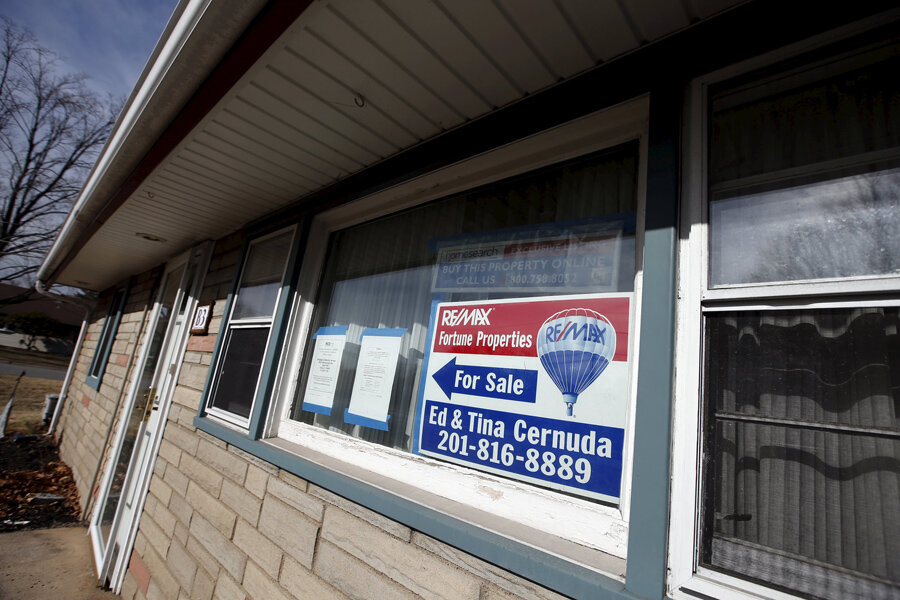US foreclosures hit 19-month high, but there's a silver lining
Loading...
US foreclosure activity reached a 19-month high in May as bank repossessions of homes continued to rise across the country. That doesn't mean the housing market is falling back into disarray, however. The short-term rise is a signal that banks finally are working through a backlog of homes long-mired in the foreclosure process, which should lead to more positive data in the long run, according to experts.
Foreclosure filings – such as default notices, scheduled auctions, and bank repossessions – increased 1 percent to more than 126,000 US properties in May 2015. Bank repossessions were down 1 percent from last month to nearly 45,000, according to California-based real estate industry firm RealtyTrac, but up a whopping 58 percent from May 2014. Last month, 38 states and the District of Columbia saw repossessions go up.
The number of scheduled foreclosure auctions also ticked up 5 percent from a year ago to about 49,400. There have been 40 percent more auctions for foreclosed homes so far this year than there were back in 2005 and 2006, before the housing bubble burst.
In Florida, one in every 409 housing units is being foreclosed, giving the state the highest foreclosure rate in the US for the third month in a row. Overall foreclosure activity in Florida was up 4 percent from April, due to the state experiencing a 63 percent year-over-year increase of banks repossessing homes. New Jersey, Maryland, Nevada, and Ohio also had the highest foreclosure rates in the country.
“May foreclosure numbers are a classic good news-bad news scenario, with the number of homeowners starting the foreclosure process stabilizing at pre-housing crisis levels but the number of homeowners actually losing their homes to foreclosure still well above pre-crisis levels and on the rise,” Daren Blomquist, RealtyTrac’s vice president, said in a press release.
May’s numbers paint a different picture for the country’s foreclosure landscape. In May 2014, US foreclosure activity dropped to an eight-year-low. In April, RealtyTrac reported that 2015’s first fiscal quarter had the lowest number of foreclosure filings since the first quarter of 2007. And 2014's foreclosure total (1.1 million) represented a 61 percent drop from 2010’s peak of nearly 2.9 million foreclosure filings, but it was also the lowest level of foreclosure activity since 2006.
In a phone interview, Mr. Blomquist says May's numbers are counter to what he and his team have seen in the past four years: Between October 2010 and February 2015, there were 53 consecutive months of year-to-year decreases in foreclosure activity. But last month's uptick was not completely unexpected; late last year, RealtyTrac saw in increase in scheduled foreclosure auctions, he says, signaling that bank repossessions would go up in three to six months, when property ownership finally transfers to the banks.
"[The banks were] gearing up for a spring cleaning of foreclosures, and that’s what happening now," Blomquist says. Meanwhile, the time properties spend in the foreclosure process nationwide increased to 620 days during the first quarter of 2015, mean ing it took 48 extra days to complete the process than it did in the first quarter of 2014. So, foreclosures that have been lingering in limbo for a long time are now being pushed through to be officially taken over by the banks, Blomquist says.
"From a macro market perspective, it’s a good sign that the market is finally dealing with lingering distressed properties," he adds. "There may some short term pain as these props hit the market, in terms of a drag on home prices and values. But, we can already see the light at the end of the tunnel."
More importantly, US foreclosure starts are still below pre-crisis levels from 2005 and 2006 when they averaged about 52,000 a month before the housing price bubble burst in August 2006. The statistic furthers the idea that there is not a huge wave of newly-distressed home owners, Blomquist says, and that the jump in bank repossessions is temporary.






